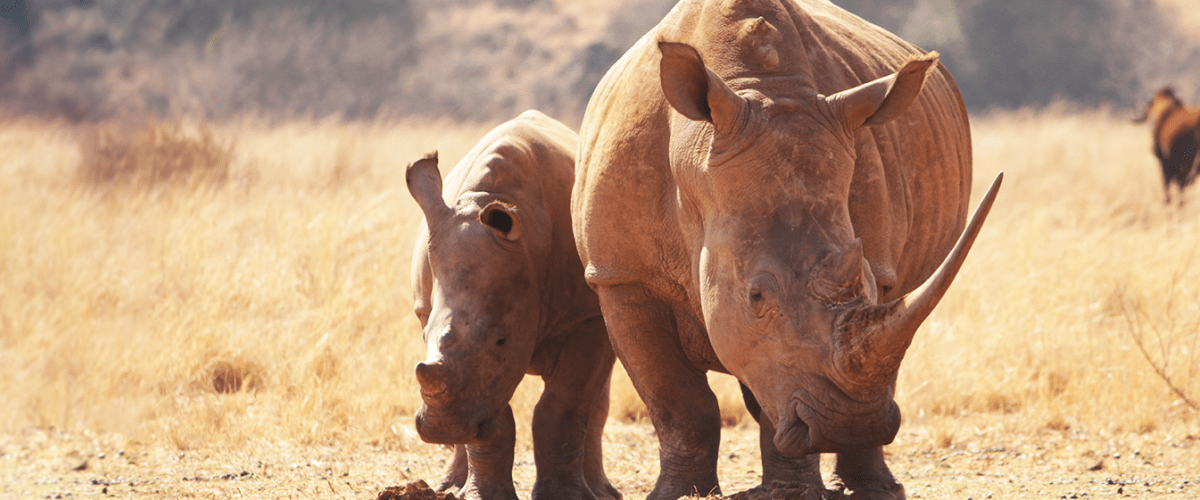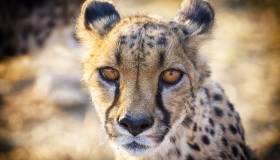
September 21, 2023 — For more than three decades, Morris Animal Foundation has championed rhinoceros health studies across all five species: white, black, Sumatran, Javan and Indian rhinoceros. The Foundation supports conservation of these iconic animals by investing in the health and welfare of both free-roaming wild animals and conservation animals living in zoos and sanctuaries.
Here are a few ways our funded studies are playing a pivotal role in safeguarding rhinoceros populations worldwide, aiding them not only to survive but also thrive.
Improving Breeding Success
Despite aggressive captive breeding programs, rhinoceros reproductive rates remain low. In the wild, female rhinoceros typically reproduce every two to five years, with only one calf per pregnancy – twins being a rarity. Conversely, birth rates for captive, conservation female rhinoceros are notably lower. Some estimates suggest that only half of captive female rhinoceros successfully reproduce, adversely impacting the species’ chances of establishing a self-sustaining population.
Our funded studies are working to change this statistic. We’ve supported the development of reproduction technologies for multiple rhinoceros species in managed breeding programs. This includes establishing reliable methods for sperm collection and freezing, as well as effective ways to test and monitor fertility and gestation. Our funded research projects also helped inform the development of early genetic databases, vital for the genetic well-being of the species and providing a buffer from poaching and mass mortality events. Both low genetic diversity and inbreeding can compromise breeding efforts and long-term survival of all five rhinoceros species.
Additionally, our studies have delved into other compounding factors, including the stress associated with housing and social conditions of captive rhinoceros. Our researchers found that high levels of stress hormones, particularly in females, were associated with reproductive problems. This underscores the importance of measuring stress hormones to improve the management of captive animals and inform breeding program efforts.
Together, these studies provide hope for boosting breeding productivity in conservation rhinoceros and long-term stability of wild populations.
Mitigating Infectious Diseases
To save endangered animals, conservationists often work to expand their habitats. This is especially pertinent for the Javan rhinoceros, which currently resides in one protected parkland in Indonesia. To bolster their chances of survival, conservationists are diligently identifying a second protected area for them.
However, before this could be undertaken, potential pitfalls, including disease risks, needed to be studied for potential pitfalls. Researchers needed to know if these sites were safe for establishing a second population of Javan rhinoceros without compromising their health and well-being. With less than 80 Javan rhinoceros left in the world, and none in captivity, every individual is valuable when it comes to saving the species.
Our funding supported several disease studies in and around the protected parkland, with a specific focus on the risk to the Javan rhinoceros from hemorrhagic septicemia – an acute, highly fatal form of pasteurellosis common in local water buffalo populations. Thanks to study findings, local government officials implemented a free vaccination program for livestock in the area. This vaccination program helped reduce the risk of disease transmission from the water buffalo to Javan rhinos and other endangered animals living in the park.
Refining Anesthesia Protocols
The conservation and health management of wild rhinoceros often requires their capture through anesthesia. While routine, capture-related complications, including life-threatening respiratory and muscle disorders from immobilization drugs, are always a concern. Our funded researchers helped reduce risk for anesthesia complications in rhinoceros in the field. The team found that positioning rhinos on their fronts after capture reduced dead space (the part of each breath that is not involved in gas exchange) and improved oxygenation. However, positioning the rhinos on their sides lowered blood lactates – indicators of insufficient oxygen in the muscles.
This study has added important new information about capture protocols, particularly emphasizing the importance of positioning rhinoceros impacts survival in the post-capture period. This work benefited all five species of rhinos, as capture and anesthesia of these large, endangered ungulates remains problematic, especially under demanding field conditions.
Ongoing Research
The Foundation continues to support studies to improve the health and well-being of rhinoceros globally. One ongoing study is investigating the role diet and gut microbiota play in both health and disease sensitivity in critically endangered southern black rhinoceros. The team is analyzing fecal and blood sample data from wild animals in hopes of providing much-needed reference health data for southern black rhinoceroses in human care as well as informing improved diets and health monitoring protocols to better care for these invaluable conservation animals.
In other studies, researchers are continuing to improve methods that decrease stress and associated health and welfare complications during immobilization and translocation of eastern black rhinoceros.
How You Can Help
While rhinoceros populations faced dramatic declines in the 20th century, investing in the health and well-being of these animals offers hope for their survival for generations to come.
Your donation today will support life-saving animal health research, ultimately contributing to the preservation of rhinoceros and other endangered animals around the world.
Resources:
- Javan Rhinos: An Ongoing Struggle to Save a Species
- On World Rhino Day, Learn About a Study Tackling Iron Overload Syndrome
- Mitigating Parasitic Disease in the Critically Endangered Javan Rhinoceros




